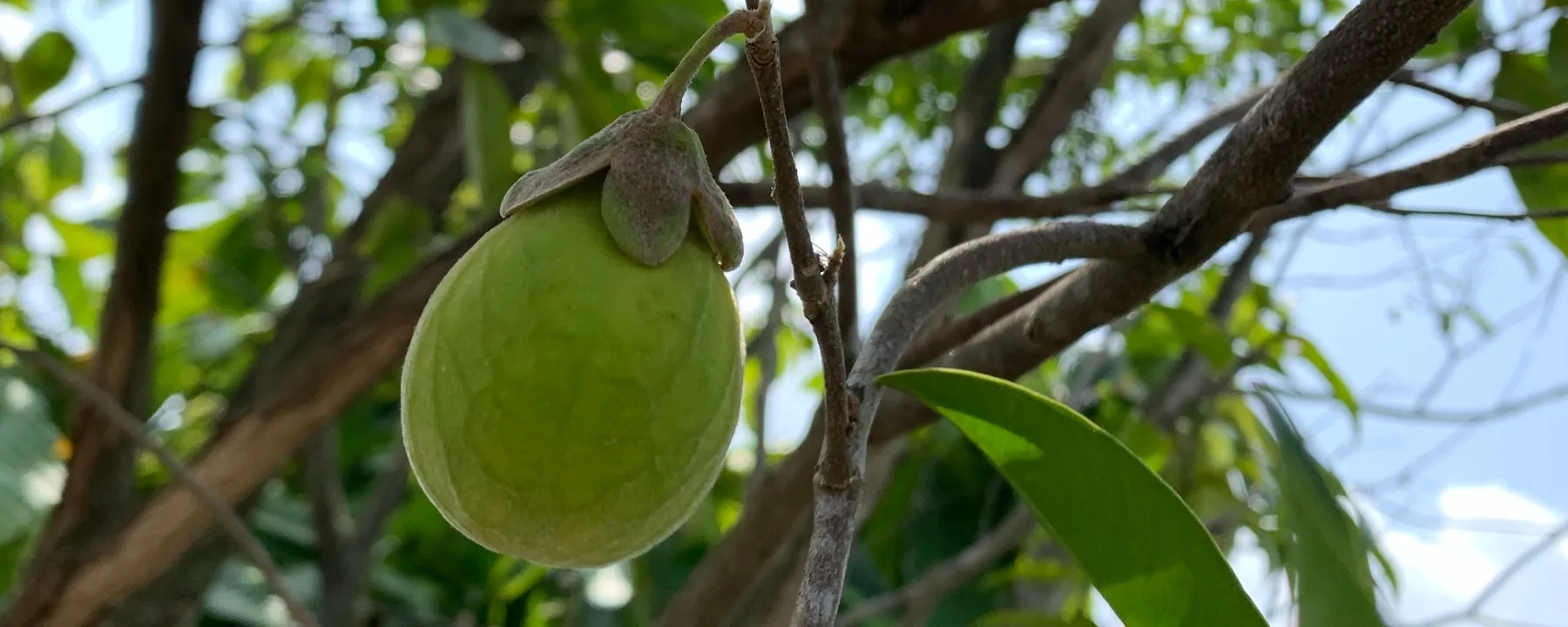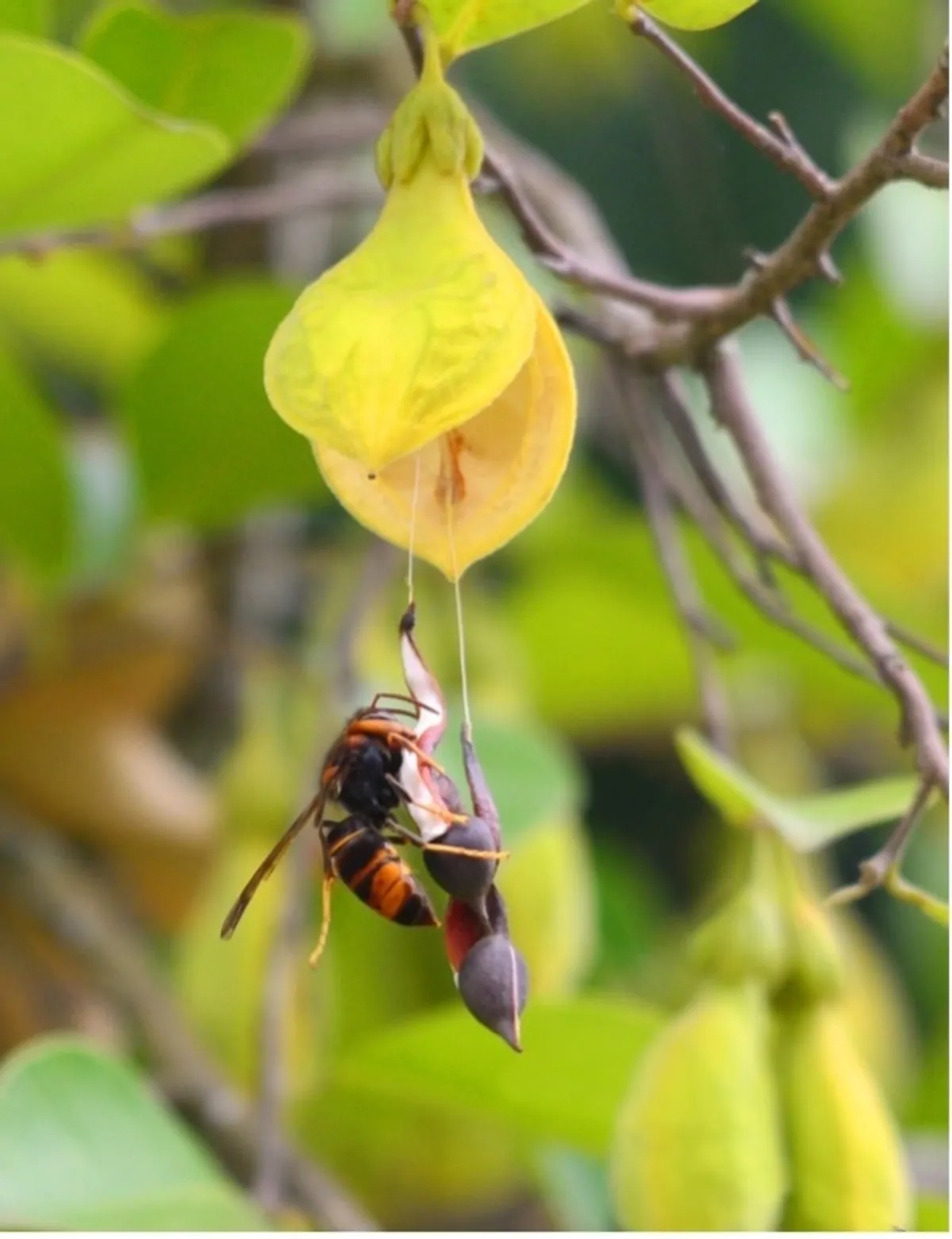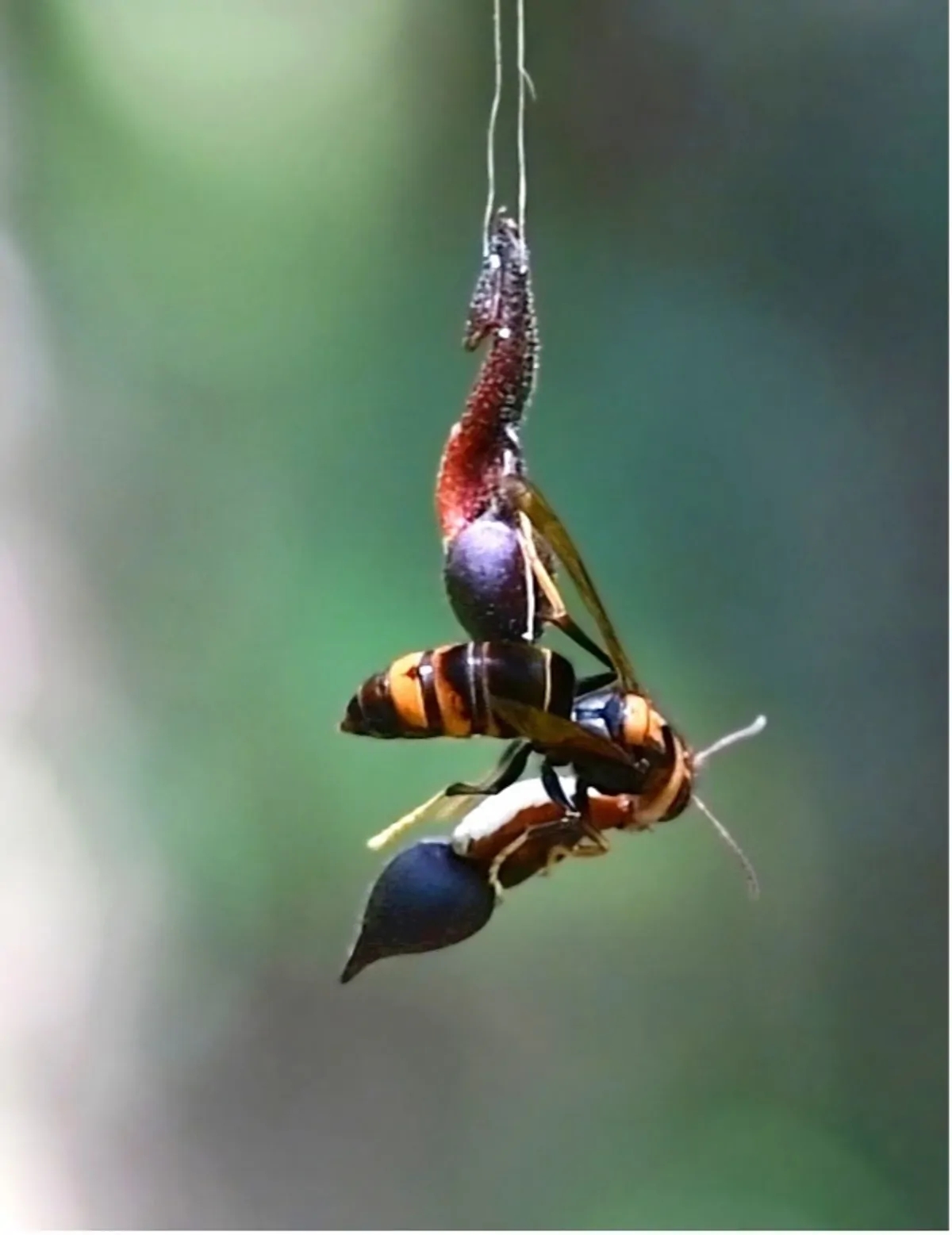Trees’ Scent Tricks Hornets Into Shuttling Seeds
Agarwood fruit smells like prey, luring carnivorous hornets, a study suggests.

Fruit of agarwood tree. (by ZHU Renbin)
Each year, the agarwood tree, a sought-after source of medicines and perfumes that grows in the rainforests of southwest China, needs to solve a problem. The tree’s fruits mature during the hottest time of the year. As temperatures climb, the fruits split and the seeds hang from the fruit, where they can dry out in a matter of hours.
To meet their ultra-fast seed-dispersal needs, the trees have tricked a species of hornets (Vespa velutina) into becoming seed couriers, a new study suggests. The work, published today (June 30) in Current Biology, describes how the agarwood’s fruit mimic the odors released when the insects start feasting on agarwood leaves. The hornets are lured in by these odors to prey on the insects but encounter a seed instead.

Vespa velutina on agarwood fruit (by ZHU Renbin)
Plants exploit animals’ senses and behavior for various reasons, says Simcha Lev-Yadun, an entomologist at Haifa University in Tel Aviv who was not involved in the study: “They do it for defense, for pollination, for seed dispersal.” But it’s thought that hornets are “usually used for pollination,” he says. “Every day you learn something that shows you that [plants] are more sophisticated than you thought,” he explains, saying it was a “joy to see a new mechanism,” in the new study that he expects will be found in other plant species as well.
In a series of field experiments performed on two agarwood tree (Aquilaria sinensis) plantations in Yunnan Province, China, researchers at the Chinese Academy of Sciences followed the fate of a total of 600 seeds on 420 just-opened fruit on four trees. They observed when and how often hornets (genus Vespa) visited the fruit. The hornets descended upon and attacked the hanging, protected seeds of the plant (called diaspores) as if they were prey just 13 minutes after the seeds emerged, on average. While three species of hornets visited the trees, V. velutina aided in dispersal of 84 percent of the seeds.
Once the hornets tore off the diaspores, they carried them to other branches or to their nests, which they usually built on large, well-shaded branches near the trunk of the tree. The hornets only consume the fleshy, outside part of the seed, called the elastiome, leaving the rest intact and viable. Overall, the hornets aided in the dispersal of 96 percent of the seeds. In separate laboratory experiments, the researchers also found that the seeds germinated in the type of shady environments favored by the hornets, suggesting that the hornets’ leftovers could survive as a next generation of agarwood trees.
The researchers tried to get a handle on what attracts the hornets to the fruit. They knew that the plants emit odors as a form of self-defense after being damaged by leaf-eating insects. After identifying the volatile compounds emitted by ripe fruit using mass spectrometry, they measured electrical activity on the hornets’ antennae in response to the presence of each chemical, and found 17 unique carbon-based odors that elicited electrical activity.

Vespa velutina on agarwood fruit (by ZHU Renbin)
Suspecting that the fruit might be mimicking compounds released when leaves are damaged by leaf-eating insects (which happen to be hornet prey), the researchers placed caterpillars (Heortia vitessoides) on A. sinensis seedlings. They analyzed the composition of the volatile molecules released by the damaged leaves, as well as the electrophysiological activity of the hornets’ antennae in response to these chemicals. They found that damaged leaves emitted 14 out of 17 chemicals emitted by the ripe fruit, and eight of these elicited high electrical activity in the hornets’ antennae. The researchers concluded that the fruit must be sending out the same volatiles the leaves deploy when eaten by a hornet’s food.
In an email to The Scientist, study coauthor Gang Wang, an ecologist at the Chinese Academy of Science’s Xishuangbanna Tropical Botanical Gardens, writes that he and his colleagues are confident that “all agarwood plants (Genus Aquilaria spp.) have this phenomenon,” since they share “similar morphological fruit traits, short-lived seeds, common herbivory, overlap with hornets’ distribution, etc.” While it’s unknown how common this phenomenon is in the plant kingdom, he says, “we are the first . . . [to examine] this topic.” He suspects that other trees with short-lived seeds may use odors to attract animals, he says: “We think the volatiles signal should be more potential attractants for rapid dispersal, as that is more effective than visual signals, which are blocked by vegetation.”
Agarwood trees are highly overexploited by humans for the resinous agarwood they produce in response to fungal infection or damage, which is often called “liquid gold” and is used for incense, perfumes, medicines, and small carvings throughout Southeast Asia. The hornet’s larvae are also cultivated for human consumption by people in the region, says Gang, and conserving both will be important for the health of the whole ecosystem, since they are part of “an ecological network.” He adds that humans may be able to take advantage of the helpful hornets’ behavior to help grow more agarwood by introducing the insects near agarwood populations.
URL: https://www.the-scientist.com/news-opinion/trees-scent-tricks-hornets-into-shuttling-seeds-70181



